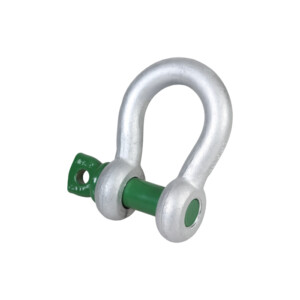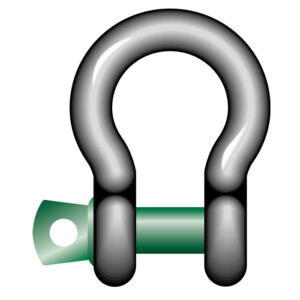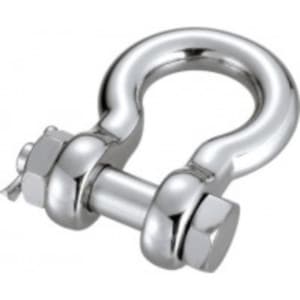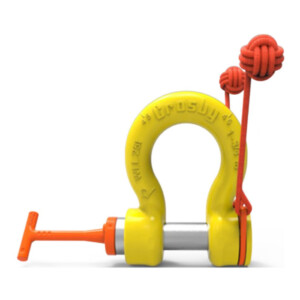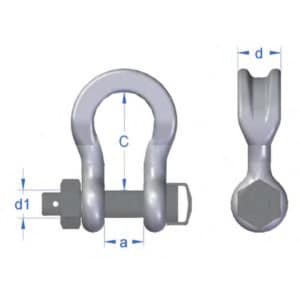Among the many invaluable tools that are used every day in the construction industry, the shackle is one of the most important.
These small, u-shaped load-bearing devices help ropes, chains, slings and more connect for a variety of purposes. You’ll find shackles in most hoisting, towing, lifting and rigging operations, which goes to indicate just how needed these appliances are.
Shackles come in all shapes and sizes, and vary depending on what the particular job in hand is. It’s important to recognise that each shackle has its own precise specifications and has been designed to fulfil a suitable task, and picking the right type of shackle can have positive implications in terms of safety and efficiency.
This guide will explore 7+ different types of shackle, how they are used in practice, and the pros and cons of each type.
7+ types of shackles you need to know
Bow Shackles
First on our list of different types of shackles is the bow shackle, or anchor shackle. A bow shackle is so called because of its distinctive O-shaped bow, which is the large loop through which ropes and slings can be pulled.
The reason a bow shackle has this shape is so that multiple sling-legs can be connected, without the risk of too greater side load. It also allows these loads to come from different directions, owing to its flared circumference.
As a result, this type of shackle is perfect for rigging, as it guarantees an easy-fastening way of securing chains and straps. Bow shackles come in a range of weight limits and colours, which allows for work to be carried out even at night when visibility can be reduced.
Advantages of bow shackles:
- They can accommodate wide lifting straps
- Perfect for secure and easy fastening rigging
- Ability to handle multiple lifting loads from different directions
Disadvantages of bow shackles:
- Lower weight tolerance than an average D-shackle
- 2 piece construction, which means a piece could be lost
Dee Shackles
One of the most common types of shackle used in day-to-day construction is a dee shackle, or ‘D’ shackle. A dee shackle is, as the name suggests, a shackle with a D-shaped shank, and is narrower than an anchor shackle.
The straightforward but effective design of a dee shackle allows it to be used with moderate to heavy lifting loads. However, due to its shape, side-loading is usually not suitable with this type of shackle as its bow may be subjected to bending should enough force be applied. An anchor shackle would be the shackle of choice in these situations.
There are numerous types of dee shackle, with differences mainly in the steel variations available. For example, depending on the supplier, you may be able to choose from alloy steel, stainless steel or galvanised steel.
Advantages of dee shackles:
- Relatively easy to maintain
- Perfect for heavy loads on a straight line
- Efficient for small and medium weight loads
Disadvantages of dee shackles:
- Bow at risk of bending under pressure
- Cannot accommodate wide lifting straps
Stainless steel shackles
Stainless steel shackles are renowned for their durability and reliability, and are often used in environments where there is a risk of corrosion. For instance, they are a popular choice in marine environments, to protect the rigging operation against the effects of salt water.
This type of shackle comes in varying grades, depending upon the stresses of the task in hand.
Advantages of stainless steel shackles:
- Durable and perfect for tough environments
- Available in a variety of tonnages
- High break loads
Disadvantages of stainless steel shackles:
- More expensive than other types of steel shackles
- Generally not suitable in general lifting operations where corrosion resistance is not required
Rov shackles
A ROV (Remotely Operated Underwater Vehicle) shackle is a specialised piece of equipment that allows for ropes and slings to connect during underwater operations.
Although ROV shackles differ in design depending on the manufacturer involved, they are typically designed to be manipulated by a hydraulically operated ROV arm.
Advantages of ROV shackles:
- Corrosion resistant
- Capable of lifting large weight loads
- Versatile and can be used in many different subsea operations
Disadvantages of ROV shackles:
- Visibility can be difficult without white coating
- Only suitable for underwater operations
Safety shackles
Another common type of shackle commonly used across the construction and lifting industries is the safety shackle. These are available in bow & dee shapes, but are different from the common bow & dee shackle as they contain a nut & pin which secures the fastening.
Known for their increased safety and reliability, these types of shackles are a common choice for lifting companies around the world, as they ensure a quick and safe connection.
Advantages of pin shackles:
- Increased Level of Safety
- Available in a range of styles and shapes
- Perfect for permanent applications
Disadvantages of pin shackles:
- It takes longer to fit safety shackles compared to screw pin shackles.
Wide body shackles
One of a range of speciality shackles that would only be used in certain circumstances, the wide body shackle contains a hefty body that allows for compatibility with high capacity web slings and wire rope slings.
Among other things, this means that there is less wear and tear on wide diameter strapping and webbing.
Advantages of wide body shackles:
- Perfect for use with certain high capacity slings
- Increases service time for slings
- Stops the lifting strap from contorting and kinking
Disadvantages of wide body shackles:
- Only really useful for wide diameter lifting straps and slings
Piling shackles
Last on our list of different types of shackles, piling shackles contain an extended D-shaped shank. The reason for this extended D-shape is that piling shackles are designed to lift steel piling sheets, whose anchor points are around 150mm distance from the top.
On construction sites where piling sheets are needed in order to stabilise ground levels, piling shackles are imperative in the safe and rapid movement of these materials.
Advantages of piling shackles:
- Only tool suitable for lifting steel piling sheets
- High break load
- Easy opening pin that will not come off when attached
Disadvantages of piling shackles:
- Not compatible with general lifting operations
- Pin can become jammed in the hole in specific situations
Closing thoughts
We hope you have enjoyed reading our definitive guide to 7+ different types of shackles.
As you’ve seen, the trusty shackle is as versatile as it is vital, and however you are planning to utilise them, there will be a shackle out there for you.
Be sure to browse through Hawk Lifting’s fantastic range of shackles to help you pick out the right one for your purpose. Alternatively, get in touch with us to discuss your individual requirements.

